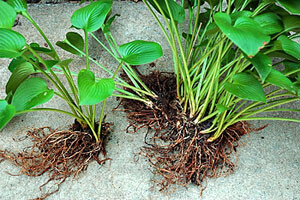
I have good news. Free plants are all around you, ready for the taking. All you need to do is divide them. To divide a plant means to dig it out of the ground and separate the parent plant into smaller sections. It’s not only an economical way to acquire additional plants; it can also be necessary to control size, or to rejuvenate it.
Armed with the knowledge that many perennials should be divided every few years for health and aesthetics comes in handy when eyeing your neighbor’s prized daylilies or coveting a fellow gardener’s hard-to-find hostas. Convincing them of the advantages of division can often make or break your success in a triumphant hosta heist or other perennial bounty.
Division is necessary for many perennials to grow and look their best. Otherwise, they can become over crowded as the plants grow out from the center above and below ground. Soil nutrients become depleted and air circulation towards the center is reduced.
Fall is the ideal time for division of most perennials but allow four to six weeks for plants to establish before the ground freezes. By now, active growth is waning, flowering is complete and the plants are settling into dormancy. Energy sources are diverted from foliage into roots and below ground reserves. Plants removed from the soil at this time don’t have the same demands as other times of year and can adapt more easily to being divided and replanted elsewhere. In the spring, they should emerge as strong and viable plants.
A good-sized clump can be sectioned into multiple pieces. However, it is important to preserve as much root tissue as possible for each division that you will transplant. This can be accomplished using several types of tools. A sharp knife, machete or a flat shovel or spade make quick work of slicing a perennial clump into multiple pieces. You can also combine two spading forks placed back to back into the clump to pull the roots apart for larger plants.
Place your new sections into other garden beds or containers as soon as possible. One of the biggest enemies to division demise is the failure to replant the separated pieces before they dry out and become unviable.
Place the new section into the soil at the same level it was growing in its original location. I prefer to enrich the soil with a small handful of bone meal and a larger portion of compost. Mix this around the root zone. Bone meal enriches the soil slowly. It contains phosphorus and is good for root stimulation without inducing new shoot or foliage growth. Compost is always good for improving soil and adding important nutrients.
To finish the project, backfill with the existing soil and water thoroughly to hydrate the roots and eliminate air pockets. An important finishing touch is to add several inches of mulch over or around your new divisions. Mulch helps keep the soil moist, temperatures more consistent and reduces the chances of cold weather heaving.
It is great to know that dividing most perennials is actually good for them. Not only does it provide an inexpensive and easy way to increase your plant collection, but it also helps to keep the plants healthy and looking their best too.